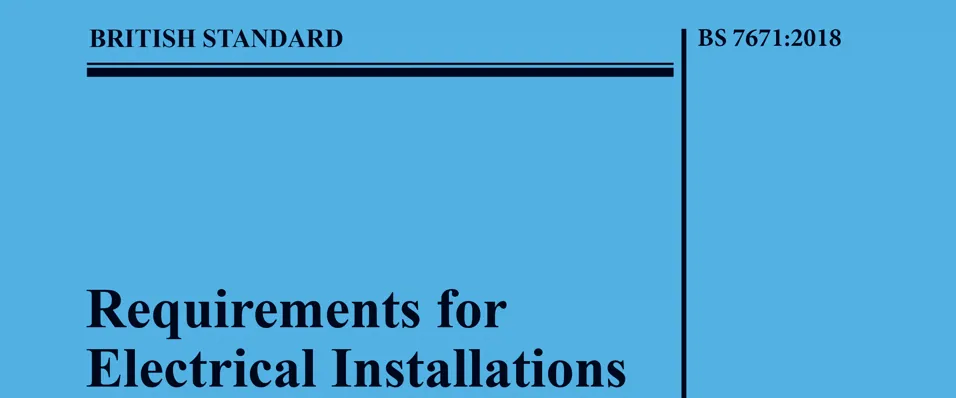
Proposed Amendment to BS 7671:2018
The DPC process is your opportunity to comment on the content of the proposed Section 722. The closing date for comments is 30 November 2019.
Protection against electric shock
Regulation 722.411.4.1 concerning the use of protective multiple earthing (PME) supply has been redrafted. Indent (iii) has been revised and now refers to a three-phase installation. In addition, Regulation 722.411.4.1 now includes an additional new indent (iv) to cover a single-phase installation. Regulation 722.411.4.1 does not allow PME to be used to supply an EV charging point unless you meet (i), or (ii), or (iii), or (iv) of 722.411.4.1. A summary of the requirements of the indents to Regulation 722.411.4.1 are as follows:
Regulation 722.411.4.1(i) refers to a situation where a connecting point is supplied from a three-phase installation used to supply loads other than charging points and where the load is sufficiently well balanced.
Regulation 722.411.4.1(ii) requires a very low resistance earth electrode to mitigate the effects of an open circuit PEN conductor fault on the supply.
As mentioned, Regulation 722.411.4.1 (iii) has been revised and now refers to a three-phase installation. The proposed new informative Annex to 722 describes that suitable arrangements include measurement of the voltage between:
- The circuit protective conductor and a suitable measurement earth electrode.
- The circuit protective conductor and a reference point derived from the line conductors of three-phase system provided that suitable precautions are also taken to disconnect the device when the supply to one or more line conductors is interrupted.
Also as mentioned, Regulation 722.411.4.1 now includes an additional new indent (iv) to cover protection by a device (or functionality within the charging equipment) for a single-phase installation.
The touch voltage threshold of 70 V mentioned in Regulation 722.411.4.1 is on the basis that Table 2c (Ventricular fibrillation for alternating current 50/60 Hz) of IEC 60479-5{ed1.0} gives a value of 71 V for both-hands-to-feet, in water-wet conditions with medium contact area (12.5 cm2).
What is PME?
The Electricity Safety, Quality and Continuity Regulations 2002 (ESQCR) (as amended) permit the distributor to combine neutral and protective functions in a single conductor provided that (in addition to the neutral to Earth connection at the supply transformer) there are one or more other connections with Earth. The supply neutral may then be used to connect circuit protective conductors of the customer’s installation with Earth if the customer’s installation meets the requirements of BS 7671.
This PME has been almost universally adopted by distributors in the UK as an effective and reliable method of providing their customers with an earth connection. Such a supply system is described in BS 7671 as TN-C-S. Whilst a protective multiple earthing terminal provides an effective and reliable facility for the majority of installations, under certain supply system fault conditions (external to the installation) a potential can develop between the conductive parts connected to the PME earth terminal and the general mass of Earth.
The potential difference between true Earth and the PME earth terminal is of importance when:
(a) body contact resistance is low (little clothing, damp/wet conditions), and/or
(b) there is relatively good contact with true Earth.
Contact with Earth is always possible outside a building and, if exposed-conductive-parts and/or extraneous-conductive-parts connected to the PME earth terminal are accessible outside the building, people may be subjected to a voltage difference appearing between these parts and Earth.
RCD protection
The proposed requirements for RCD protection have been redrafted. The regulation now contains further requirements for Type B and Type A or Type F RCDs to take account of DC fault current as follows (extract below):
“Except where provided by the EV charging equipment, protection against DC fault currents shall be
provided by:
(i) an RCD Type B; or
(ii) an RCD Type A or Type F in conjunction with a residual direct current detecting device
(RDC-DD) complying with BS IEC 62955 as appropriate to the nature of the residual and superimposed currents and recommendation of the manufacturer of the charging
equipment.”
ANNEX A722 (Informative)
The proposed new Annex A722 has been redrafted. The Annex now includes guidance on the voltage monitoring device described in Regulation 722.411.4.1 (iii). Also, the Annex now includes an example arrangement of a separated system described in Regulation 722.413.
Conclusion
It is important to note that this article only gives a brief overview of the proposed Amendment to BS 7671:2018. For more information please refer to the DPC. It is important to highlight that at this stage these are draft proposals only. The DPC is your opportunity to offer your insight into the proposed changes. The DPC is available on BSI’s website and everyone is invited to view the draft and submit comments by the deadline of 30 November 2019.
